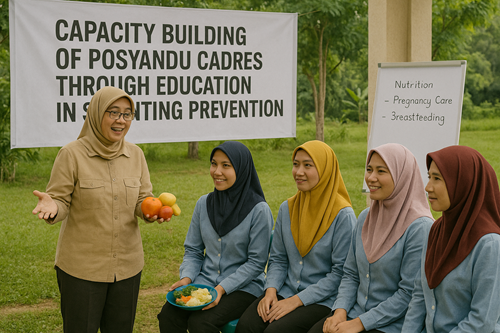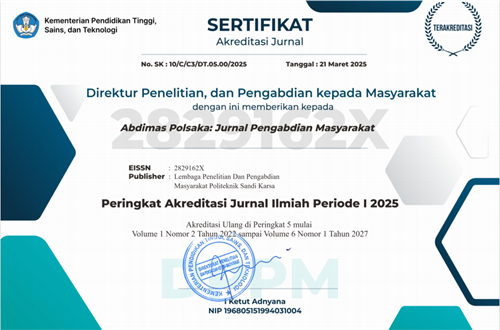Capacity building of posyandu cadres through education and training in stunting prevention
DOI:
https://doi.org/10.35816/abdimaspolsaka.v4i1.84Keywords:
capacity building, education, stunting preventionAbstract
Increasing the capacity of Posyandu cadres is a strategic step in efforts to prevent stunting at the community level. The Community Service Program (PkM) aims to improve the knowledge and skills of Posyandu cadres in preventing stunting through education and training. The methods used include providing interactive materials, simulations, and field practices on risk factors, nutritional parenting, and early detection of stunting. The program participants are Posyandu cadres in the assisted areas with 30 people. The evaluation results showed a significant improvement in the knowledge and skills of cadres, which was measured through pre-test and post-test. In addition, cadres can apply the knowledge gained in Posyandu activities, such as educating mothers under five years old, detecting stunting risks, and developing simple intervention programs in the community. In conclusion, practice-based education and training effectively increase Posyandu cadres' capacity for stunting prevention. This program is expected to contribute to reducing the prevalence of stunting in the assisted areas
Downloads
References
Adam, N., Fitrianingsih, J., & Basir, M. (2024). The role of knowledge in improving attitudes and behaviors of stunting prevention in pregnant women. Jurnal Ilmiah Kesehatan Sandi Husada, 13(2 SE-Book Review). https://doi.org/https://doi.org/10.35816/jiskh.v13i2.1230
Adrizain, R., Faridah, L., Fauziah, N., Berbudi, A., Afifah, D. N., Setiabudi, D., & Setiabudiawan, B. (2024). Factors influencing stunted growth in children: A study in Bandung regency focusing on a deworming program. Parasite Epidemiology and Control, 26, e00361. https://doi.org/https://doi.org/10.1016/j.parepi.2024.e00361
Aris Tyarini, I., Setiawati, A., Septiyana Achmad, V., & Astuti, A. (2023). Improving Healthy Behavior in Preventing Stunting through Digital Media. Abdimas Polsaka, 2(2), 97–103. https://doi.org/https://doi.org/10.35816/abdimaspolsaka.v2i2.47
Astuti, S. J. W., Suindyah, S., & Atmojo, S. (2025). Modeling environmental interactions and collaborative interventions for childhood stunting: A case from Indonesia. Dialogues in Health, 100206. https://doi.org/https://doi.org/10.1016/j.dialog.2025.100206
Dable-Tupas, G., Talampas-Abundo, M. D., Abundo, I. C. S., & Derecho, C. M. P. (2023). 7 - Nutrigenomics in the management and prevention of malnutrition, stunting, and other nutritional disorders. In G. Dable-Tupas & C. B. T.-R. of N. in M. H. and D. D. Egbuna (Eds.), Drug Discovery Update (pp. 147–175). Elsevier. https://doi.org/https://doi.org/10.1016/B978-0-12-824412-8.00005-9
Erika, K. A., Fadilah, N., Latif, A. I., Hasbiah, N., Juliaty, A., Achmad, H., & Bustamin, A. (2024). Stunting Super App as an Effort Toward Stunting Management in Indonesia: Delphi and Pilot Study. JMIR Human Factors, 11. https://doi.org/https://doi.org/10.2196/54862
Gaston, R. T., Ramroop, S., & Habyarimana, F. (2024). Modelling the interrelationships between potential risk factors and childhood Co-morbidity of Malaria, Anaemia, and stunting in children less than five years in Burundi. Heliyon, 10(19), e38525. https://doi.org/https://doi.org/10.1016/j.heliyon.2024.e38525
Hermawan, D., Kurniasari, D., Sandayanti, V., Sari, N., & Listyaningsih, E. (2023). Relationships of deworming drug consumption and animal protein intake with stunting. Parasite Epidemiology and Control, 23, e00326. https://doi.org/https://doi.org/10.1016/j.parepi.2023.e00326
Jokhu, L. A., & Syauqy, A. (2024). Determinants of concurrent wasting and stunting among children 6 to 23 mo in Indonesia. Nutrition, 122, 112390. https://doi.org/10.1016/j.nut.2024.112390
Lewis, J. I., Mbabazi, J., Mutumba, R., Ritz, C., Filteau, S., Briend, A., Michaelsen, K. F., Mølgaard, C., Wells, J. C., Mupere, E., Friis, H., & Grenov, B. (2024). Correlates of Body Composition in Children with Stunting: A Cross-sectional Study in Uganda. The Journal of Nutrition, 154(10), 3105–3115. https://doi.org/https://doi.org/10.1016/j.tjnut.2024.08.001
Linggi, E. B., Nurhanifah, D., Kamaruddin, M. I., Angreni, W. O. N., Suprapto, S., & Napolion, K. (2024). Knowledge and Attitude Can Increase Participation in Elderly Posyandu Visits. Window of Health: Jurnal Kesehatan, 451–460. https://doi.org/https://doi.org/10.33096/woh.v7i4.1399
Locks, L. M., Chembe, M., Billima- Mulenga, T., Lauer, J. M., Sizakawe, D., Henderson, S., Rockers, P. C., Parkerson, D., & Fink, G. (2024). Predictors of Stunting and Pathway Analysis for Linear Growth among Children Aged Two to Three Years after a Trial of Small-Quantity Lipid-Based Nutrient Supplements and Home-Installed Growth Charts in Three Districts in Zambia. The Journal of Nutrition. https://doi.org/https://doi.org/10.1016/j.tjnut.2024.11.003
Meher, C., & Zaluchu, F. (2025). Methods for stunting education in impoverished rural areas using illustrated modules in local languages. MethodsX, 14, 103086. https://doi.org/https://doi.org/10.1016/j.mex.2024.103086
Ode Novi Angreni, W., Arda, D., Setyawati, A., Sasmita, A., Aris Tyarini, I., & Nordianiwati, N. (2024). Exclusive breastfeeding in preventing stunting in toddlers. Jurnal Edukasi Ilmiah Kesehatan, 2(1), 07–13. https://doi.org/https://doi.org/10.61099/junedik.v2i1.29
Oginawati, K., Yapfrine, S. J., Fahimah, N., Salami, I. R. S., & Susetyo, S. H. (2023). The associations of heavy metals exposure in water sources to the risk of stunting cases. Emerging Contaminants, 9(4), 100247. https://doi.org/https://doi.org/10.1016/j.emcon.2023.100247
Soofi, S. B., Khan, G. N., Sajid, M., Hussainyar, M. A., Shams, S., Shaikh, M., Ouma, C., Azami, S., Naeemi, M., Hussain, A., Umer, M., Hussain, I., Ahmed, I., & Ariff, S. (2024). Specialized nutritious foods and behavior change communication interventions during the first 1000 d of life to prevent stunting: a quasi-experimental study in Afghanistan. The American Journal of Clinical Nutrition, 120(3), 560–569. https://doi.org/https://doi.org/10.1016/j.ajcnut.2024.07.007
Sri Dahrianti, E., Rasdin, R., Idhan, M., & Nengsiana, N. (2024). Counseling on Early Prevention of Stunting at Maccini Sombala. Abdimas Polsaka, 3(1), 47–52. https://doi.org/https://doi.org/10.35816/abdimaspolsaka.v3i1.71
Supadmi, S., Laksono, A. D., Kusumawardani, H. D., Ashar, H., Nursafingi, A., Kusrini, I., & Musoddaq, M. A. (2024). Factor related to stunting of children under two years with working mothers in Indonesia. Clinical Epidemiology and Global Health, 26, 101538. https://doi.org/https://doi.org/10.1016/j.cegh.2024.101538
Suprapto, Kamaruddin, M. I., Herlianty, & Nurhanifah, D. (2024). Building Nurse Competency Strategy at Public Health Center in Indonesia: A Descriptive Qualitative Approach. The Malaysian Journal of Nursing, 15(03), 62–70. https://doi.org/10.31674/mjn.2024.v15i03.008
Tyarini, I. A., Setiawati, A., Rahagia, R., & Maidelwita, Y. (2024). Community empowerment in stunting prevention and control to build a healthy and productive generation. Jurnal Pengabdian Masyarakat Edukasi Indonesia, 1(3), 100–106. https://doi.org/10.61099/jpmei.v1i3.56
Wand, H., Moodley, J., Reddy, T., & Naidoo, S. (2024). Geospatial correlations and variations in child mortality and stunting in South Africa: Evaluating distal vs structural determinants. Spatial and Spatio-Temporal Epidemiology, 50, 100653. https://doi.org/10.1016/j.sste.2024.100653
Zamani-Alavijeh, F., Heidari, Z., Mostafavi-Darani, F., Mirzaei-Alavijeh, M., & Saber, F. (2025). Investigating the psychometrics of a new tool for evaluating motivational factors and their relationship with stunts among adolescent male cyclists in Isfahan, Iran. Transportation Research Part F: Traffic Psychology and Behaviour, 108, 73–88. https://doi.org/10.1016/j.trf.2024.11.014

Additional Files
Published
How to Cite
Issue
Section
License
Copyright (c) 2025 Abdimas Polsaka

This work is licensed under a Creative Commons Attribution 4.0 International License.
Most read articles by the same author(s)
- Rasi Rahagia, Nour Sriyanah, Indrawati Aris Tyarini, Anita Lontaan, Muh Yunus, Upaya Pencegahan Stunting Berbasis Edukasi dan Sosialisasi , Abdimas Polsaka: Vol. 2 No. 1 (2023): Abdimas Polsaka: Jurnal Pengabdian Masyarakat
- Indrawati Aris Tyarini, Ari Setiawati, Viyan Septiyana Achmad, Astuti Astuti, Improving Healthy Behavior in Preventing Stunting through Digital Media , Abdimas Polsaka: Vol. 2 No. 2 (2023): Abdimas Polsaka: Jurnal Pengabdian Masyarakat
- Wa Ode Novi Angreni, Rasi Rahagia, Ari Setyawati, Muh. Ihsan Kamaruddin, Suprapto Suprapto, Community participation in clean and healthy living as an effort to improve the quality of health , Abdimas Polsaka: Vol. 3 No. 1 (2024): Abdimas Polsaka: Jurnal Pengabdian Masyarakat
- Ari Setyawati, Glendy Ariando Salomon, Nordianiwati Nordianiwati, Risna Ayu Rahmadani, Herlina Herlina, Meningkatkan Kapasitas Kader Posyandu dalam Upaya Pencegahan dan Penanganan Stunting , Abdimas Polsaka: Vol. 2 No. 1 (2023): Abdimas Polsaka: Jurnal Pengabdian Masyarakat
- Nordianiwati Nordianiwati, Nur Gilang Fitriana, Lamria Situmeang, Indrawati Aris Tyarini, Ari Setyawati, Education on the role of family in stunting prevention in toddlers , Abdimas Polsaka: Vol. 3 No. 1 (2024): Abdimas Polsaka: Jurnal Pengabdian Masyarakat
- Fifi Alviana, Ari Setyawati, Muhammad Chadzik Masruri, Mutingatul Hofsoh, Prevention Of Bullying in Adolescents with Assertive Communication and Happy Spiritual , Abdimas Polsaka: Vol. 2 No. 2 (2023): Abdimas Polsaka: Jurnal Pengabdian Masyarakat
- Sulistyani Prabu Aji, Sumarmi Sumarmi, Rida' Millati, Yoga Tri Wijayanti, Indrawati Aris Tyarini, Increasing Community Nutrition Awareness through Balanced Nutrition Education Program , Abdimas Polsaka: Vol. 3 No. 1 (2024): Abdimas Polsaka: Jurnal Pengabdian Masyarakat
- Lamria Situmeang, Rida Millati, Tridamayanty Syamsul, Indrawati Aris Tyarini, Ari Setiawati, Yefta Primasari, Improving parenting and healthy nutrition for stunted toddler mothers through community service programs , Abdimas Polsaka: Vol. 3 No. 2 (2024): Abdimas Polsaka: Jurnal Pengabdian Masyarakat
- Risna Ayu Rahmadani, Prasetyowati Prasetyowati, Indrawati Aris Tyarini, Rasi Rahagia, Matilda Martha Paseno , Nutritious food education and the practice of providing complementary foods are appropriate in efforts to prevent stunting , Abdimas Polsaka: Vol. 4 No. 2 (2025): Abdimas Polsaka: Jurnal Pengabdian Masyarakat




















